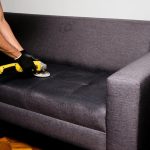To safely clean your cotton upholstery and avoid shrinking, first vacuum or brush off loose dirt. Use a mild detergent diluted with warm water and test it on a hidden spot to check for colorfastness. Gently blot stains with a soft cloth—never rub. After cleaning, air dry your fabric in a well-ventilated space, avoiding direct heat and sunlight to prevent damage. Keep moisture controlled throughout to protect fibers. If you want more tips on maintaining your cotton upholstery’s look and feel, keep exploring effective care methods.
Table of Contents
Key Takeaways
- Use a gentle cleaning solution of warm water and mild detergent to avoid damaging cotton fibers and causing shrinkage.
- Always test cleaning solutions on a hidden area to check for colorfastness and fabric reaction before full application.
- Blot stains gently without rubbing, using a damp cloth to prevent pushing dirt deeper or stretching the fabric.
- Air dry upholstery in a well-ventilated area away from direct sunlight and heat sources to prevent shrinking and fading.
- Vacuum regularly with a soft brush attachment to remove dirt and debris, preserving fabric texture and preventing wear.
Understanding Cotton Fabric and Its Sensitivities
Although cotton is a durable and popular fabric for upholstery, you need to understand its sensitivities before cleaning it.
Cotton fibers absorb moisture easily, which makes them prone to shrinking and color fading if exposed to excessive water or harsh detergents. You should also know that cotton can wrinkle and lose its shape if not handled gently.
Avoid using high heat when drying, as this can damage the fabric. Additionally, cotton upholstery often has a dye that might bleed if cleaned improperly, so test any cleaning solution on a hidden spot first.
Preparing Your Cotton Upholstery for Cleaning
Before you start cleaning, check the fabric tags on your cotton upholstery to understand any specific care instructions.
Next, remove any loose debris by vacuuming or gently brushing the surface.
These steps help guarantee a safe and effective cleaning process.
Inspect Fabric Tags
When you’re getting ready to clean your cotton upholstery, start by inspecting the fabric tags closely. These tags give you essential info on how to clean the fabric safely without damaging it or causing shrinkage. Look for cleaning codes, fiber content, and any warnings. If the tag is missing or unreadable, test a hidden area before proceeding.
| Tag Symbol | Meaning |
|---|---|
| W | Use water-based cleaner |
| S | Use solvent cleaner only |
| WS | Use water or solvent |
Knowing these codes helps you pick the right cleaning method, avoiding costly mistakes. Always follow the manufacturer’s instructions on the tag to keep your cotton upholstery looking great and lasting longer.
Remove Loose Debris
Start by removing all loose debris from your cotton upholstery to guarantee a thorough cleaning. This step prevents dirt from embedding deeper during the cleaning process, keeping your fabric fresh and vibrant.
Begin by:
- Vacuuming the surface with a brush attachment to lift dust and crumbs.
- Using a lint roller to pick up pet hair and small particles.
- Gently shaking out removable cushions outdoors to dislodge trapped debris.
- Brushing off loose dirt with a soft-bristled brush to avoid fabric damage.
Taking these actions assures your cotton upholstery is free from surface grime, making the cleaning process more effective and reducing the risk of stains setting in.
Always handle the fabric gently to maintain its texture and avoid unnecessary wear.
Essential Cleaning Tools and Materials
You’ll need gentle cleaning solutions to protect your cotton upholstery’s fabric.
Using soft tools like microfiber cloths helps avoid damage while cleaning.
Plus, controlling moisture is key to preventing water stains and mold growth.
Gentle Cleaning Solutions
Although cotton upholstery is durable, treating it with gentle cleaning solutions helps preserve its texture and color. You want to avoid harsh chemicals that can weaken fibers or cause fading. Instead, opt for mild options that effectively clean without damage.
Here are some gentle cleaning solutions to keep on hand:
- A mix of mild liquid dish soap and warm water
- White vinegar diluted with water for deodorizing
- Baking soda paste for spot cleaning stains
- Commercial upholstery cleaners labeled safe for cotton
Before applying any solution, test it on a hidden area to verify it doesn’t affect the fabric’s color or texture.
Using these gentle cleaners will maintain your cotton upholstery’s look and feel while preventing shrinkage or wear.
Soft Cleaning Tools
When cleaning cotton upholstery, choosing soft cleaning tools is essential to protect the fabric’s integrity. Hard brushes or abrasive sponges can damage fibers and cause pilling or distortion. Instead, select gentle tools that effectively lift dirt without harsh friction. Microfiber cloths, soft-bristle brushes, and natural sponges are excellent choices. They help you clean thoroughly while preserving softness and color.
| Tool Type | Purpose | Tips for Use |
|---|---|---|
| Microfiber Cloth | Lifting dust and stains | Use dampened, not soaked |
| Soft-Bristle Brush | Agitating dirt gently | Brush in fabric grain direction |
| Natural Sponge | Applying cleaning solution | Squeeze excess liquid before use |
| Cotton Cloth | Blotting and drying | Pat gently, avoid rubbing |
| Vacuum with Upholstery Attachment | Removing loose dirt | Use low suction setting |
Using these tools, you’ll maintain your cotton upholstery’s beauty and durability.
Moisture Control Methods
After selecting gentle tools for cleaning cotton upholstery, managing moisture properly becomes just as important.
Too much water can cause shrinking or damage, so you need to control how damp your fabric gets. Here’s how to get it right:
- Use a spray bottle to lightly mist the surface instead of pouring water directly.
- Blot excess moisture immediately with a clean, dry microfiber cloth.
- Avoid soaking the upholstery; focus on small sections at a time.
- Allow the fabric to air dry completely, preferably with good ventilation or a fan.
Spot Testing Before Full Cleaning
Why should you always perform a spot test before cleaning your cotton upholstery? Because it helps you avoid unexpected damage like color fading, shrinking, or fabric distortion.
Different cotton fabrics react uniquely to various cleaning agents and methods. By testing a small, hidden area first, you can see how your upholstery responds without risking the entire piece.
Apply a small amount of your chosen cleaner, wait a few minutes, then blot gently to check for color transfer or fabric changes. If the spot looks unaffected, you’re good to proceed. If not, try a milder cleaner or consider professional help.
Spot testing is a simple step that safeguards your upholstery, ensuring you clean it effectively without causing harm or costly repairs.
Step-by-Step Guide to Hand Cleaning Cotton Upholstery
Now that you’ve tested the fabric, you’re ready to prepare a gentle cleaning solution for your cotton upholstery.
Focus on spot cleaning carefully to avoid damaging the fibers.
Finally, make sure to dry the fabric properly to prevent any shrinking.
Preparing Cleaning Solution
Before you start cleaning your cotton upholstery, you’ll need to prepare an effective and gentle cleaning solution. This guarantees you remove dirt without damaging the fabric or causing shrinkage.
Start by filling a bowl with warm water—not hot, as heat can shrink cotton. Add a mild detergent that’s safe for delicate fabrics. Avoid harsh chemicals or bleach. Mix gently to create suds, but don’t overdo it; too much soap can leave residue.
Here’s what you’ll need:
- Warm water (about 1 quart)
- Mild liquid detergent (1 teaspoon)
- A clean bowl or bucket
- A soft cloth or sponge for application
Mix these carefully, and your solution will be ready to safely clean your cotton upholstery.
Gentle Spot Cleaning
With your cleaning solution ready, you can tackle spots on your cotton upholstery carefully to avoid damage.
First, dip a clean white cloth into the solution and wring out excess liquid. Gently blot the stained area without rubbing, as scrubbing can damage the fibers. Work from the outside of the stain toward the center to prevent spreading.
After blotting, switch to a dry cloth to absorb moisture. Repeat this process until the spot fades. Avoid soaking the fabric; less moisture means less risk of shrinking.
Once the stain lifts, let the area air out naturally. Remember, patience is key—rushing might push the stain deeper or harm the cotton.
With gentle spot cleaning, you preserve your upholstery’s look and texture effectively.
Drying Without Shrinking
To dry your cotton upholstery without shrinking, you’ll need to control moisture and temperature carefully. Start by blotting excess water with a clean, dry towel—never rub.
Then, follow these steps to guarantee safe drying:
- Place the upholstery in a well-ventilated area away from direct sunlight.
- Use a fan to circulate air gently around the fabric.
- Avoid heat sources like radiators or hair dryers, which can cause shrinking.
- Allow the fabric to air dry completely before using or storing.
Using a Gentle Vacuum for Routine Maintenance
Although cotton upholstery is durable, it still requires regular care to stay fresh and clean.
Using a gentle vacuum for routine maintenance helps you remove dust, dirt, and debris without damaging the fabric. Choose a vacuum cleaner with adjustable suction and a soft brush attachment to avoid pulling or stretching the cotton fibers.
Vacuum your upholstery at least once a week, focusing on crevices and seams where dirt tends to accumulate. Move the vacuum gently in the direction of the fabric’s weave to prevent abrasion.
This method not only keeps your cotton looking bright but also extends its lifespan by preventing buildup that can cause wear. Regular vacuuming guarantees your upholstery stays comfortable and inviting between deeper cleanings.
How to Use Mild Detergents Safely on Cotton
Keeping your cotton upholstery clean goes beyond vacuuming; sometimes, stains and dirt require a more thorough approach using mild detergents.
To protect your fabric and avoid damage, follow these tips:
- Test the detergent on a hidden area first to check for colorfastness.
- Dilute the detergent with water to reduce its strength before applying.
- Use a soft cloth or sponge, gently dabbing rather than scrubbing to prevent fiber stress.
- Rinse the area with a clean, damp cloth to remove detergent residue.
Drying Techniques to Prevent Shrinkage
When you dry cotton upholstery improperly, it can easily shrink and lose its shape. To prevent this, always air dry your cotton pieces flat on a clean, dry surface, avoiding direct sunlight which can cause fading and weaken fibers.
If you hang the fabric, use padded hangers to maintain shape and prevent stretching. Avoid using high heat from dryers, as intense temperatures cause cotton to contract. Instead, opt for a low heat or no-heat setting if machine drying is necessary, but air drying remains best.
Gently blot excess moisture with a towel before drying to reduce drying time and stress on fibers. Taking these precautions helps maintain your cotton upholstery’s size, texture, and overall appearance.
When to Avoid Machine Washing or Drying
If your cotton upholstery has delicate embroidery, loose seams, or is attached to wooden frames, you should avoid machine washing or drying. These processes can damage the fabric and structure, causing shrinkage or weakening the material.
Instead, consider gentler cleaning methods to preserve your upholstery’s integrity.
Opt for gentle cleaning techniques to maintain the strength and appearance of your upholstery.
Avoid machine washing or drying when:
- The fabric has intricate stitching or embellishments.
- The upholstery is glued or stapled to a frame.
- There are loose seams or frayed edges.
- The care label specifically warns against machine cleaning.
Tips for Maintaining Cotton Upholstery Between Cleanings
Although cotton upholstery is durable, you’ll want to take simple steps to keep it looking fresh between deep cleanings.
Regularly vacuum your furniture using a soft brush attachment to remove dust and debris that can wear down fibers over time.
Rotate cushions frequently to guarantee even wear and prevent sagging.
Avoid placing your cotton upholstery in direct sunlight, as it can cause fading and weaken the fabric.
Quickly address spills by blotting with a clean, dry cloth—don’t rub, as that can spread stains.
Consider using fabric protectors designed for cotton to repel stains and spills.
Finally, keep pets’ nails trimmed and avoid eating on your furniture to minimize damage.
These small habits will extend the life and appearance of your cotton upholstery.
Frequently Asked Questions
Can Professional Cleaning Services Damage Cotton Upholstery?
You might worry professional cleaning services could damage your cotton upholstery, but skilled cleaners use proper techniques to avoid harm. Just guarantee they specialize in delicate fabrics so they don’t accidentally cause shrinking or color fading.
How Often Should Cotton Upholstery Be Deep Cleaned?
You should deep clean your cotton upholstery every 12 to 18 months to keep it fresh and spotless. Regular vacuuming between deep cleans helps maintain its appearance and prevents dirt buildup that can cause wear.
Are There Eco-Friendly Cleaning Products Safe for Cotton?
You can definitely find eco-friendly cleaning products safe for cotton upholstery. Look for natural ingredients like vinegar, baking soda, or plant-based detergents. Always test a small area first to guarantee they won’t cause damage or discoloration.
Can Sunlight Exposure Fade Cotton Upholstery Colors?
Yes, sunlight can fade cotton upholstery colors over time. You should avoid prolonged direct exposure by using curtains or shades. Rotating cushions regularly also helps keep the color even and vibrant longer.
What Are Signs That Cotton Upholstery Needs Repair Before Cleaning?
You’ll notice frayed threads, loose seams, or thinning fabric when your cotton upholstery needs repair. Check for stains or odors too. Fixing these issues before cleaning prevents further damage and keeps your furniture looking great.
- The Use of Nonwovens in Construction and Civil Engineering - July 11, 2025
- The Use of Nonwovens in Construction and Civil Engineering - July 11, 2025
- The Use of Nonwovens in Construction and Civil Engineering - July 11, 2025







